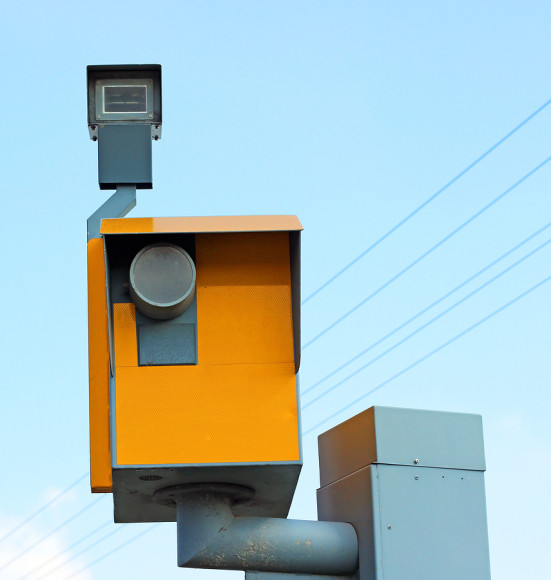Municipalities that installed traffic cameras to boost revenue are scraping for cash to fill budget gaps after complaints by irate drivers forced them to cancel their use.
Nassau County on Long Island ended its program after speed cameras led to the issuance of more than 400,000 tickets in less than two months, opening a $90 million budget hole over the next three years. In Ohio, Dayton is cutting in half its number of police cruisers, and Linden, New Jersey, is shelving plans to hire more cops after both states effectively ended camera systems following a backlash from motorists.
Cameras that monitor speed and red lights have become a quick way to raise revenue for cash-strapped U.S. local governments. While the programs are touted as a way to make roads safer, the perception among drivers is that municipalities are using cameras solely to pump up their coffers, said Bill Seitz, the Ohio lawmaker who led his state’s charge against them.
Red-Light Cameras: Safety Measure or Money Grab?
“There’s some evidence that perhaps they do promote safety,” Seitz, a Republican senator, said by phone. “The costs outweigh the benefits, and the revenue-enhancement feature of this predominates over safety.”
U.S. Trend
Ohio, New Jersey and New York’s Nassau County moved to effectively end their camera programs this month, joining a national trend. Speed cameras are already banned in at least a dozen states, according to the Insurance Institute for Highway Safety. The number of red-light camera programs in the U.S. dropped to 469 this month from a high of 540 in 2012.
“They’re a political liability, but it’s an easy way to raise revenue without raising taxes,” said Howard Cure, head of municipal research at Evercore Wealth Management LLC in New York, which oversees $5.6 billion.
Still, relying on traffic cameras isn’t a long-term solution to revenue shortfalls because drivers eventually figure out where they are, Cure said.
In Nassau County, Republican County Executive Ed Mangano and legislators used the $30 million in projected annual revenue from speed cameras to help persuade a state control board to end a three-year wage freeze. Then the residents spoke up.
Angry Residents
As many as 56 cameras positioned near schools led to 400,308 tickets in only two months, triggering an outcry.
“The program angered residents to a point where it was outweighing the improved safety,” said Cristina Brennan, a spokeswoman for Norma Gonsalves, who leads the Republican majority in the Nassau legislature.
The county of about 1.4 million residents east of New York City was already facing a deficit of about $200 million next year — before the program ended.
“The cameras were one of the shiny objects the county seems perpetually attracted to,” said Chris Wright, a member of the control board who voted against lifting the wage freeze in May.
Mangano and the Republican majority in the legislature have agreed to make up the $30 million by increasing a surcharge on mobile phones for 911 service, ending a subsidy to a local hospital and selling billboard advertising space, among other measures, said Brian Nevin, a Mangano spokesman.
“While speeding motorists dislike tickets, it’s clear the program has changed driving habits for the better,” Mangano said in an e-mailed statement.
N.J. Pilot
From September, when the full program began, through November, the average number of tickets issued per day dropped 64 percent, according to a Dec. 11 report by the Nassau County Office of Legislative Budget Review.
In New Jersey, a five-year pilot program ended Dec. 16 after Governor Chris Christie, a 52-year-old Republican, opted not to renew it. Assemblyman Declan O’Scanlon, the most vocal legislator against them, celebrated with a midnight party at the Brick House Tavern & Tap near a South Plainfield intersection that had been watched by cameras.
For Linden, a city of 41,000 near Newark Liberty International Airport, the program’s end means losing as much as $1.5 million from a $100 million budget, said Mayor Richard J. Gerbounka. As in New York, local governments in New Jersey are prohibited from raising property taxes by more than 2 percent annually.
Budget Blow
“Regardless of what state you’re in, but particularly in ones that have property-tax caps, governments have looked at areas where they can get other revenues,” said Robert Weber, a Moody’s Investors Service analyst in New York. Weber wrote a Dec. 18 report that said ending camera programs was a blow to localities, including 25 in New Jersey.
Linden was planning to add as many as eight police officers, Gerbounka said by phone.
“You can forget about that,” he said.
Programs in Ohio are effectively ending after Governor John Kasich, a Republican, signed Seitz’s bill Dec. 19. It requires a police officer to be posted by every camera. Ohio’s constitution essentially blocks the state from doing an outright ban, Seitz said.
Dayton, a city of 143,000 near the Indiana border, will lose $1.4 million of the $150 million the city takes in annually, said Tim Riordan, the city manager. To close the gap, Dayton will cut the number of police cruisers to eight from 16 and cut its street-resurfacing program to $700,000 from $1.7 million, Riordan said.
“We did them because it was a way to do safety with the state cutting a lot of money,” Riordan said by phone. “These cuts will have a direct impact on people that they’ll see.”
–With assistance from Kate Smith in New York.
Topics USA New York New Jersey Ohio
Was this article valuable?
Here are more articles you may enjoy.



 Experian: AI Agents Could Overtake Human Error as Major Cause of Data Breaches
Experian: AI Agents Could Overtake Human Error as Major Cause of Data Breaches  Supreme Court Rejects Challenge to $2.46B Boy Scouts Sex Abuse Settlement
Supreme Court Rejects Challenge to $2.46B Boy Scouts Sex Abuse Settlement  10 Highest Class-Action Settlements in 2025 Eclipsed $70B Total: Duane Morris
10 Highest Class-Action Settlements in 2025 Eclipsed $70B Total: Duane Morris  SIAA Announces Strategic Partnership With Progressive
SIAA Announces Strategic Partnership With Progressive 

